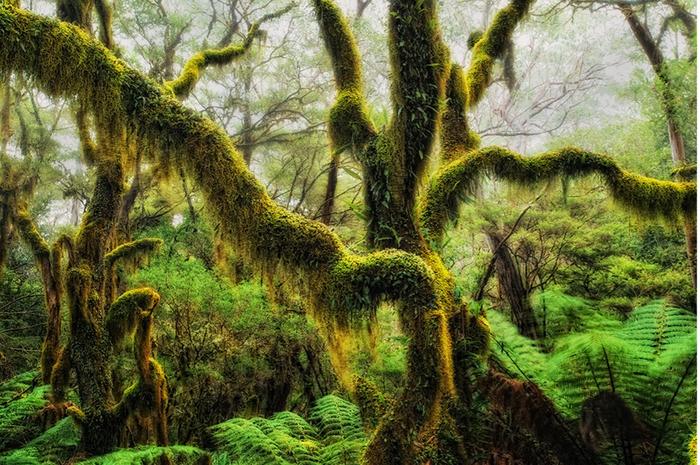For decades, the scientific consensus has been that cool temperate rainforests, such as those found in Australia, are fragile ecosystems susceptible to various disturbances, including fire and logging. This prevailing notion framed these ancient forests as entities that must be meticulously safeguarded from any disruptive forces. However, recent groundbreaking research conducted by the University of Melbourne has led to a dramatic reassessment of this perspective. The study indicates that rather than only being vulnerable, cool temperate rainforests depend on disturbances for their health and sustainability, calling for a revolution in how these ecosystems are managed.
At the heart of the study is the Antarctic beech, scientifically known as Nothofagus moorei, which plays a crucial role as a keystone species in these rainforests. This towering tree not only provides structural support for the ecosystem, but it also facilitates a wide array of biodiversity. The research team drew upon data collected from historical silvicultural experiments initiated in the 1960s. By examining 15 distinct plots in northern New South Wales, the study assessed various levels of canopy removal—an essential variable for understanding the ecological responses of rainforest species to disturbances.
Utilizing advanced statistical modeling techniques, the researchers meticulously analyzed multiple variables including growth and mortality rates of the trees in the aftermath of disturbances, alongside recruitment success for new tree species. This sophisticated approach revealed a rather surprising outcome: Nothofagus moorei exhibited enhanced growth rates and a higher success rate in species recruitment following disturbances of greater intensity. Significantly, nearly 60% of the 30 tree species evaluated in the study displayed the capacity to resprout following disturbances, showcasing the remarkable resilience inherent in these cool temperate rainforests.
The implications of these findings extend far beyond mere academic curiosity; they advocate for a paradigm shift in conservation strategies. The lead researcher, Kate A. Simmonds, emphasizes that entirely excluding all forms of disturbance could paradoxically jeopardize the survival of pivotal species such as N. moorei. This revelation paints a more intricate picture of forest dynamics, suggesting that moderate disturbances play a vital role in maintaining ecological diversity and balance within these ancient forests.
As climate change amplifies the frequency and intensity of fire regimes across Australia, the pressing need for effective forest management becomes glaringly evident. The study introduces the concept of managed disturbance regimes—controlled interventions that mimic natural processes—as a potential key to safeguarding these ecosystems. Such an approach could provide forest managers with actionable insights that align ecological resilience with proactive conservation measures, ensuring the long-term survival of species that have weathered millennia.
The research underscores the complex interdependence between disturbance and biodiversity. This notion runs counter to the traditional thinking that prioritizes strict protective measures against any form of ecological disruption. Instead, the findings advocate for a more nuanced understanding of how disturbances can invigorate forest ecosystems, offering a crucial lifeline in the face of rapidly changing environmental conditions.
Recent findings from Melbourne have significant ramifications for ecological research and conservation policy, effectively blurring the lines between what is conventionally deemed ‘natural’ and ‘artificial’ management strategies. The results urge scientists and conservationists alike to embrace a more dynamic perspective on ecosystem health, one that acknowledges disturbances as productive forces rather than threats. This philosophical shift opens new avenues for investigating ecosystem processes and biodiversity conservation.
The study’s insights are particularly timely, given the rapidly evolving landscape brought on by climate fluctuations. As ecosystems face unprecedented stressors, the foundational principles through which we understand their dynamics may need to be re-evaluated. Consequently, the evidence suggesting that disturbances can foster rather than hinder biodiversity offers a ray of hope for conservationists striving to protect these vital habitats.
In tandem with these scientific revelations, ongoing support from institutions like the Bushfire and Natural Hazards Cooperative Research Centre and New South Wales National Parks and Wildlife Service highlights the collective effort needed to foster sustainability in forest ecosystems. As collaborative research endeavors continue to illuminate the intricacies of temperate rainforests, they lay the groundwork for informed management practices that can adapt to the ecological challenges posed by climate change.
In conclusion, the transformative research conducted by the University of Melbourne redefines our understanding of cool temperate rainforests and their relationship to disturbance. This study champions the notion that ecological resilience is inherently tied to the presence of disturbances, thus reshaping the future of conservation strategies. As we navigate an era marked by environmental uncertainty, these vital ecosystems can be sustained through informed management practices that welcome, rather than shun, the natural forces that have long shaped their existence.
Subject of Research: Cool temperate rainforests and their ecological response to disturbances
Article Title: Half a century of demographic responses of Nothofagus cool temperate rainforests to disturbance
News Publication Date: February 15, 2025
Web References: http://dx.doi.org/10.1016/j.fecs.2025.100308
References: N/A
Image Credits: Drew Hopper
Keywords: Nothofagus moorei, Antarctic beech, cool temperate rainforests, ecological resilience, disturbance, conservation strategies, climate change, biodiversity, forest management




